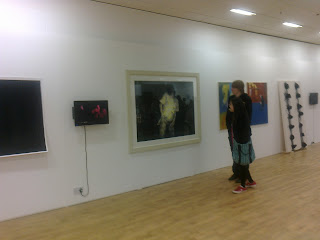Thanks to the
Arts Council England I have just had news that I have been awarded a grant to print a series of large-scale screen-prints which are screen grabs of Youtube birth videos. I will be working at
Hotbed Press in Salford where I have a studio to make the series of 7 works.
Раждане с оргазъм (Birth by orgasm)
http://www.youtube.com/watch?v=Kbp3iff5OOc&feature=related
Four-colour screen-print on Fabriano paper 101 x 147 cm 2011
Раждане с оргазъм (Birth by orgasm)
http://www.youtube.com/watch?v=Kbp3iff5OOc&feature=related
Detail of four-colour screen-print on Fabriano paper 101 x 147 cm 2011
Раждане с оргазъм (Birth by orgasm)
http://www.youtube.com/watch?v=Kbp3iff5OOc&feature=related
Detail of four-colour screen-print on Fabriano paper 101 x 147 cm 2011
The first exhibition of this work will be in February of 2012 for the
Digital Romantics show at the D
ean Clough Gallery curated by
David Hancock. You can see the initial print which I made in July 2011 working with Ivan Liotchev to develop a way of exposing the image using a digital projector. This project is also supported by
Screen Stretch and Screen Tec and
Turners Art Materials
Crossley Gallery Dean Clough Halifax.
Digital Romantics
With: Iain Andrews, Andrew Brooks, Clare Booker, darkcorner (Simon Woolham), David Hancock, Ian Kirkpatrick & Julien Masson, Helen Knowles, James Moore, Tom Ormond, Kari Stewart.
Stunning landscapes, moody urban dystopias, costumed fantasies and ecstatic tableaux: but just because there’s a computer chip involved in all of them, doesn’t mean that what Coleridge had to say about the imagination, or Burke about the sublime, or Carlyle about heroes doesn’t apply. The widely admired painter and curator David Hancock has brought together ten artists from around the UK for this unique exhibition of paintings, photographs, prints and sculptures – all of which manifest Romantic obsessions in a digital world. These are artists who pose as many challenges to the self-regarding (and self-rewarding) avant-garde as they do to the vaunted sensibilities of traditional ‘art lovers’; but in their acknowledgement of digital consumerism their scrutiny of contemporary life is perhaps more urgent than either group cares to admit.





















+detail.jpg)







